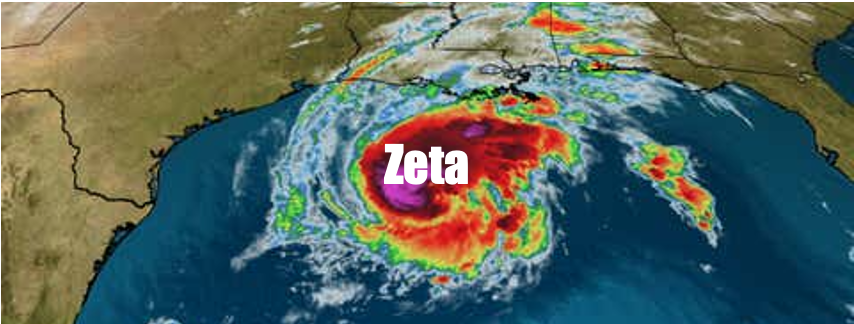CAT Loss Guide
Jeff Esper
Policyholders Guide for CAT Claims from Zeta

Property damage insurance claims are among the most infrequent for corporate policyholders, but this year Louisiana has suffered through a record number of Hurricanes. When catastrophe strikes, recovering insured losses essential to rebuild and resume operations. Effected policyholders will need expert help to evaluate, organize and document their claim to present to insurers. Forensic accountants that devote their practice to preparing claims for policyholders have every day experience just as adjusters and auditors do, so it is certainly to your advantage to hire a firm of experts to represent your interests throughout the property damage and time element claim process.
Though the specific insurance claims and the policyholders may change, the vital steps to recovery remain the same. One thing both sides agree on is that the claim process goes smoother when the policyholder is well prepared for demands of a claim from start to finish.
The partners at RWH Myers prepared a detailed guide to assist policyholders in preparation for claim recovery. It is designed to serve as a resource and a framework for the claim process and includes the following sections:
- Establish Appropriate Accounting Methodology: Provides guidance and an organizational framework for post-loss activities, establishing specific accounts to capture the loss.
- Property Damage Expense Categories:
Explains the types of expenses that may be included in each category of coverage and the documentation required for these costs.
- Claim Preparation Objectives and Overview:
Identifies objectives for the claim preparation process, and provides a conceptual framework for achieving them.
- What is Covered:
Examines the direct and indirect exposures to loss that are typically encountered, and provides guidelines for determining whether specific types of property damage losses are covered under the policy.
- Claim Preparation Procedures:
Suggests timetables for the submission of inventory, property damage, and discusses the format and content of standard claim submissions.
- Audit and Settlement Guidelines:
Discusses the procedures undertaken by the insurers adjusters and experts, and provides an overview of the settlement process.
Click here
to download the full guide.
Insights Worth Sharing

Making a business interruption claim is more than just an accounting exercise. It requires a good strategy, a thoughtful process and perhaps most of all, patience. These lessons come from experience and the team at RWH Myers has earned it from decades of preparing BI claims. Though this topic is of the philosophical nature, it is just as important as the details behind a business interruption calculation. So let’s dive in and see what you really need to make a BI claim. Strategy Every loss is different. You can’t apply the same game plan and the same approach to every claim. You have to assess the situation and all its parts to devise a specific workable strategy. Experience will help ensure your strategy is appropriate for the situation, but the claim will take on a life of its own. The initial loss assessment is derived from the loss information such as what happened, the timeline of events, the impact to operations and how long it will take to get back to normal. As forensic accountants, we will look at the entirety of the situation and dissect it from every angle to figure out the full scope of loss and then determine the best approach to measuring and supporting the claim. We will also anticipate how the claim will be adjusted and plan for arguments against the claim. Taking the time to develop a proper strategy will pay off at every stage of the claim process. Process Once you understand the situation and have designed an effective strategy, you can lay out a process to get to the desired result. The process starts off with identifying and assembling the team to execute the plan. The claim will require data from various sources and input from key internal experts to provide insights as to the impact on operations, both upstream and downstream. The process also includes managing claim adjustment, from setting the timeline to handling requests for information. During the process, your claim preparer will work to keep all phases of the claim moving forward whether with data gathering or insurer feedback. Claims tend to start out with a high level of attention, but it is common to lose momentum. Simply put, a well-defined process will keep the claim moving, limiting distractions and roadblocks. Patience Patience doesn’t equate to conceding to a lengthy and arduous process. It’s just the opposite. By definition, it means, “quietly and steadily persevering or being diligent, especially in detail or exactness.” It is important to understand that certain parts of the claim take time to develop, and that time is critical to ensuring a thorough and well thought out claim presentation. For example, taking your time in the beginning of the process to lay out the foundational elements of the claim will avoid obstacles that may delay claim settlement and the amount recovered. It’s best to set expectations early and commit to the process. Again, practicing patience will expedite the claim process and improve the outcome. You can rely on the experience of your forensic accounting team to lead that effort. So, you see, it’s not all about the numbers. There is more to the intangibles than you may have thought. Every claim has its own unique challenges. You should be prepared for anything and everything. Again, preparing a claim is just as much strategy, process, and patience as it is the technical elements of claim preparation.

When damage occurs from hurricanes, policyholders are faced with hurricane deductibles which are common in states along the Atlantic and Gulf Coasts. The meaning of "hurricane" may be determined by the policy wording or by state law. Generally, a windstorm is considered a hurricane only if is declared as such by National Weather Service. Though percentage deductibles have been used over the years, after Hurricane Andrew in 1992, percentage deductibles became more popular in policies especially after Katrina in 2005 dealing out $125 billion in damage. The common misconception is that the percentage applies to the loss sustained when in fact the percentage deductible is a factor of the total insured value (TIV). The policy wording can be confusing making it difficult to decipher and apply to your loss. We’re here to help you understand these deductibles and how they will apply should you be impacted by a hurricane. Here are a few items to look for in your policy: The following notice may appear on your policy cover - Florida information: "THIS POLICY CONTAINS A SEPARATE DEDUCTIBLE FOR HURRICANE LOSSES, WHICH MAY RESULT IN HIGH OUT-OF-POCKET EXPENSES TO YOU." The percentage may be based on various parameters. It may be per location or be more defined by structure. When it’s applied by structure it can be more advantageous for policyholders since the percentage would apply only to that structures TIV. It may pertain separately to property and time element losses of affected location(s) or it may combine business interruption and property. It is important to understand your specific policy’s wording to accurately calculate your out-of-pocket expenses before insurance kicks in. Further, contingent losses may again involve a separate percentage deductible. Percentage deductibles are often associated with a minimum deductible and, less common a maximum deductible. Here are a few examples of policy wording related to CAT loss deductibles: When a % deductible is stated above, whether separately or combined, the deductible is calculated as follows: Property Damage – % of the value, per the Valuation clause(s) of the PROPERTY DAMAGE section, of the property insured at the location where the physical damage happened. Time Element – % of the full Time Element values that would have been earned in the 12 month period following the occurrence by use of the facilities at the location where the physical damage happened, plus that proportion of the full Time Element values at all other locations where TIME ELEMENT loss ensues that was directly affected by use of such facilities and that would have been earned in the 12 month period following the occurrence. As respects property located in high hazard zones for earth movement: Property Damage: 5% per location, Time Element: 5% per location The above are subject to a minimum deductible of USD500,000 or if applicable the location deductible for Property Damage and Time Element combined, per location and a maximum deductible of USD15,000,000, combined all coverages, per occurrence. When a % deductible is stated above, whether separately or combined, the deductible is calculated as follows: Property Damage – % of the value, per the Valuation clause(s) of the PROPERTY DAMAGE section, of the property insured at the location where the physical damage happened. Time Element – % of the full Time Element values that would have been earned in the 12 month period following the occurrence by use of the facilities at the location where the physical damage happened, plus that proportion of the full Time Element values at all other locations where TIME ELEMENT loss ensues that was directly affected by use of such facilities and that would have been earned in the 12 month period following the occurrence. Deductibles for CAT losses have become more complex over the years. Interdependent operations spread the impact of loss across the organization, so it’s increasingly challenging to have confidence in the preliminary evaluation, especially when informing key stakeholders. Those who have had losses know, with hindsight, there are gaps in understanding and initial questions that are critical to the deductible evaluation. Our advice is to avail yourself of a candid, independent review from the start so that whether you have a recoverable claim or not, you’ll be informed and prepared.


